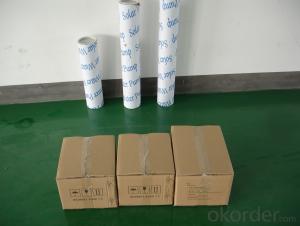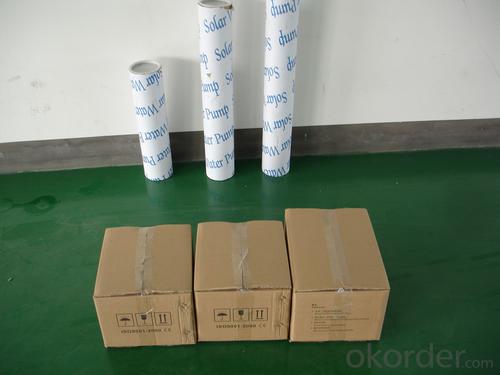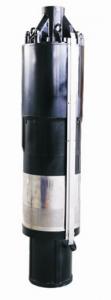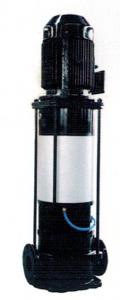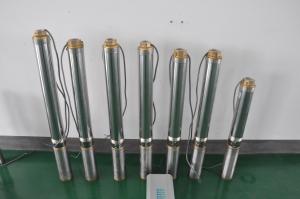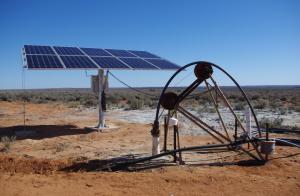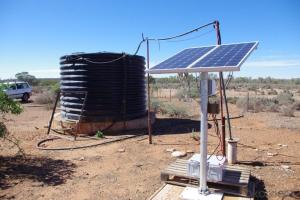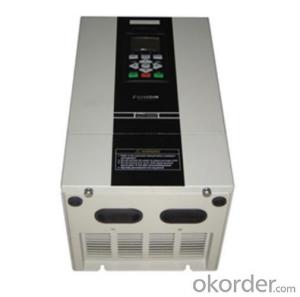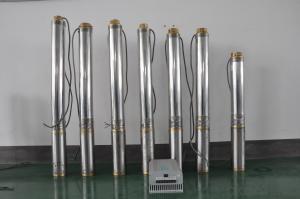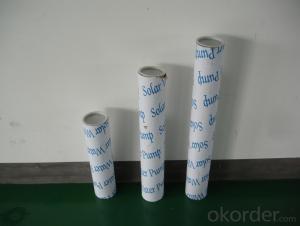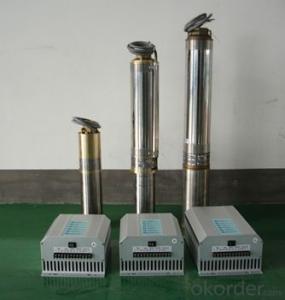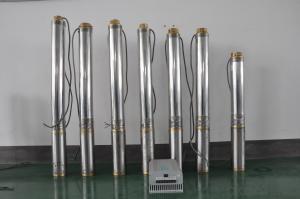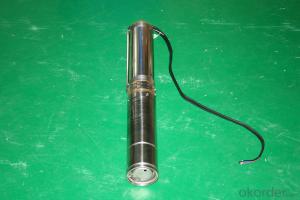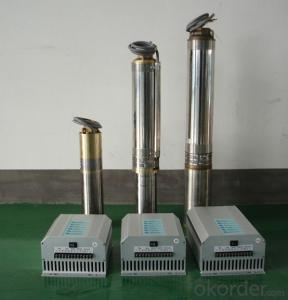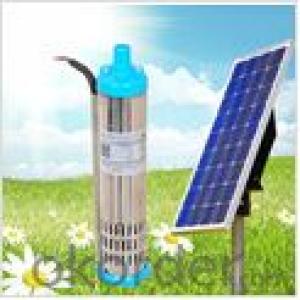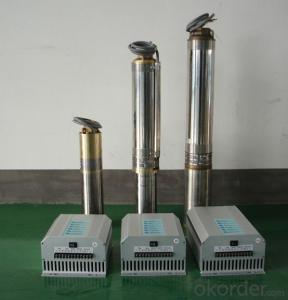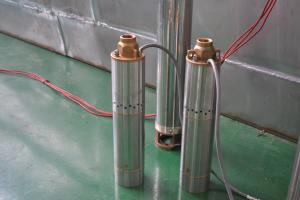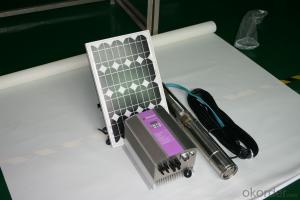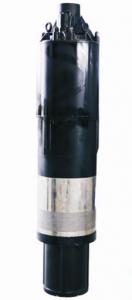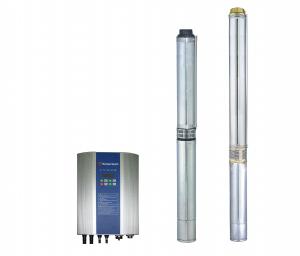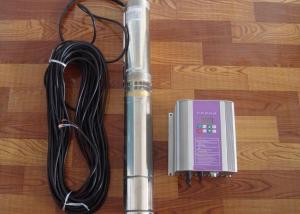Inline Solar DC Submersible Water Pumps
- Loading Port:
- China Main Port
- Payment Terms:
- TT OR LC
- Min Order Qty:
- -
- Supply Capability:
- -
OKorder Service Pledge
OKorder Financial Service
You Might Also Like
Item Description :
This superb new addition to our solar fountain range comes with a 10w solar panel,and a powerful fountain pump that is capable of producing fountains of up to 2m in height. As well as being easy to set up and use.Instruction manual is supplied for assembly and maintenance.
Solar Fountain Key Features :
Powered by direct sunlight
No high voltage electric mains required
Safe for children
Max. height of fountain: 2M
Max. flow capacity: 800 L/H(176 GAL)
10W Polycrystalline solar panel included
18V DC brushless pump
Solar Pump Features :
Can produce fountains up to : 2M (tube height) 1.4M (fountain height)
Comes with multiple nozzle accessories
Cable Length : 5M
Solar Panel Features :
10W peak power.
Polycrystalline highly efficient solar panel
Comes mounted in aluminium frame
Comes with ground stake and rotating knob so you can angle your panel toward the sun
What You Will Get :
10W solar panel
Solar pump
Ground Sake
Nozzle accessories
Precautions :
DO NOT alter or change the product itself or its components
Operate pump in freshwater only, never above 50 degrees celsius
Keep away from flammable liquids
Do not connect to any other power supply other than the included
- Q: Can solar pumps be used for water supply in agricultural research or experimental farms?
- Yes, solar pumps can be used for water supply in agricultural research or experimental farms. Solar pumps are a sustainable and cost-effective alternative to traditional pumps, as they utilize renewable energy from the sun to power the pumping system. They can help ensure a reliable water supply for irrigation purposes in these farms, reducing dependence on fossil fuels and lowering operational costs. Additionally, solar pumps are environmentally friendly and contribute to the overall sustainability goals of agricultural research and experimental farms.
- Q: How does the size of the pump motor affect the performance of a solar pump?
- Determining the performance of a solar pump heavily relies on the size of the pump motor. The flow rate, pressure, and overall efficiency of the pump are directly influenced by the motor size. When the pump motor is larger, it enables a higher flow rate, resulting in the ability to pump more water within a given time period. This is particularly important in scenarios where a substantial amount of water needs to be transported, such as in agricultural irrigation or large-scale water supply systems. A higher flow rate guarantees the effective and efficient delivery of the desired volume of water. Moreover, the size of the pump motor impacts the pump's ability to generate pressure. A larger motor is capable of creating higher pressure, which becomes necessary when pumping water to elevated areas or overcoming resistance in an extensive pipe network. The increased pressure ensures that water reaches its intended destination with sufficient force and can be evenly distributed across the irrigation system or other applications. Furthermore, a larger motor often leads to improved efficiency. With a more powerful motor, the pump requires less time to complete its pumping cycle, resulting in reduced energy consumption. This not only saves costs but also promotes a more sustainable utilization of solar energy. It is important to note that while a larger motor generally offers better performance, it also demands more energy to operate. Therefore, it is crucial to find a balance between motor size and energy availability. If the solar array providing power to the pump cannot generate enough electricity to operate a larger motor, it may be necessary to opt for a smaller motor that can still meet the required performance levels without exceeding the available energy supply. To conclude, the size of the pump motor significantly impacts the performance of a solar pump. A larger motor allows for higher flow rates, increased pressure, and improved efficiency. However, it is essential to consider the available energy supply when selecting the motor size to ensure optimal performance and energy utilization.
- Q: Are solar pumps more cost-effective than traditional pumps?
- Solar pumps are a more cost-effective option compared to traditional pumps. Despite the higher initial investment, solar pumps have significantly lower operating costs throughout their lifespan. By utilizing renewable energy from the sun, solar pumps eliminate the need for expensive electricity or fuel, which can be subject to price fluctuations. Moreover, solar pumps require minimal maintenance and have a longer lifespan, resulting in reduced replacement and repair expenses. Additionally, solar pumps often qualify for government incentives and subsidies, further reducing the overall cost. The cost-effectiveness of solar pumps is particularly evident in areas with abundant sunlight, making them a reliable and cost-efficient solution for water pumping, especially in remote or off-grid locations.
- Q: Are there any limitations on the water pressure that can be achieved with a solar pump?
- Yes, there are limitations on the water pressure that can be achieved with a solar pump. The pressure is dependent on various factors such as the power and efficiency of the solar panels, the size and depth of the water source, and the design and capacity of the pump itself. Additionally, the distance and elevation that the water needs to be pumped can also affect the achievable water pressure. Therefore, it is important to consider these factors and select the appropriate solar pump for the desired water pressure requirements.
- Q: Can a solar pump be used in areas with high salinity in water?
- Yes, a solar pump can be used in areas with high salinity in water. Solar pumps are versatile and can handle a wide range of water sources, including those with high salinity. The pump's components are designed to withstand corrosive environments, ensuring its durability and functionality in such areas. Additionally, solar pumps can be equipped with filtration systems to remove any impurities or salt content present in the water, further facilitating their use in high salinity areas.
- Q: What is the required voltage for a solar pump?
- The required voltage for a solar pump can vary depending on the specific model and application. However, most solar pumps typically operate at low voltages, usually ranging from 12 volts to 48 volts.
- Q: Are there any specific installation requirements for a solar pump in a well?
- For a solar pump to be installed in a well, there are specific requirements that need to be considered. Here are some important factors to keep in mind: 1. Placement of Solar Panels: To maximize sunlight exposure, it is necessary to install the solar panels in a location where they receive maximum sunlight throughout the day. It is ideal to mount them at an angle and facing south to optimize solar energy capture. 2. Depth and Size of Pump: The size and type of solar pump required will depend on the depth and diameter of the well. Selecting a pump that can handle the well's depth and deliver the desired water flow rate is crucial. 3. Mounting of Pump: To ensure proper performance, the solar pump should be securely mounted and correctly aligned within the well casing. This prevents any movement or misalignment that could impact its functionality. 4. Wiring and Control Box: Appropriate wiring and connectors are needed to connect the solar panels to the pump motor. Additionally, a control box may be necessary to regulate the power supply and safeguard the pump from voltage fluctuations. 5. Safety Precautions: It is important to take adequate safety measures during installation. This may involve grounding the system, using suitable circuit breakers or fuses, and adhering to local electrical codes. 6. Maintenance and Monitoring: Regular maintenance and monitoring are vital for optimal performance and durability of the solar pump system. This includes cleaning the solar panels, inspecting wiring connections, and checking the pump's operation. To ensure that all specific installation requirements are met and to achieve the best results from a solar pump in a well, it is advisable to consult a professional solar pump installer or a qualified technician.
- Q: How does the maintenance cost of a solar pump system compare to a traditional electric pump?
- The maintenance cost of a solar pump system is generally lower compared to a traditional electric pump. This is primarily due to the fact that solar pumps have fewer moving parts and no complex electrical systems, which reduces the risk of mechanical failure and the need for extensive maintenance. Solar pumps are powered by solar panels, which have a long lifespan and require minimal maintenance. The main maintenance tasks for a solar pump system involve checking and cleaning the solar panels regularly to ensure optimal performance. Additionally, the pump itself may require occasional maintenance such as lubrication and inspection of connections. In contrast, traditional electric pumps require more regular maintenance due to the complexity of their electrical systems and moving parts. Electric pumps often have motors, wiring, and other components that can wear out over time and require maintenance or replacement. The electrical connections also need to be regularly inspected and maintained to prevent any potential issues. Furthermore, traditional electric pumps are typically connected to the grid, which means they are subject to fluctuations in electricity prices. This can result in higher operational costs compared to solar pumps, which rely on the sun's energy and do not incur any ongoing electricity expenses. Overall, while both solar pump systems and traditional electric pumps require maintenance, the maintenance cost of a solar pump system tends to be lower due to the simpler design, fewer moving parts, and reduced reliance on external sources of power.
- Q: How does the cleanliness of the solar panels affect the performance of a solar pump system?
- The performance of a solar pump system is greatly affected by the cleanliness of its solar panels. These panels are specifically designed to convert sunlight into electricity, which is essential for powering the pump system. However, the efficiency of the panels significantly decreases when they become dirty or covered in dust, leaves, bird droppings, or other debris. When dirt and debris accumulate on the surface of the solar panels, they obstruct the sunlight from reaching the photovoltaic cells. As a result, the cells are unable to generate electricity effectively. This leads to a decrease in the overall power output of the solar panels, directly impacting the performance of the pump system. Insufficient power may cause the pump to operate below its optimal levels, resulting in reduced water flow or even complete system failure. To maintain the efficiency and performance of solar panels, regular cleaning and maintenance are essential. Cleaning the panels removes dirt, dust, and other debris, allowing maximum sunlight to reach the photovoltaic cells. This ensures that the panels can generate the necessary electricity to power the pump system efficiently. In areas with high levels of air pollution or dusty environments, it may be necessary to increase the frequency of cleaning. Neglecting regular cleaning can lead to a significant decrease in the performance of the solar pump system, resulting in operational inefficiencies and higher energy costs. In conclusion, the cleanliness of solar panels directly affects the performance of a solar pump system. Regular cleaning and maintenance are crucial to ensure optimal power generation and efficient operation of the pump system. By keeping the panels clean, the system can operate at its full potential and provide a consistent water flow for various applications.
- Q: How does a solar pump handle water source contamination from industrial waste?
- A solar pump alone does not directly handle water source contamination from industrial waste. However, it can be part of a larger water treatment system that helps address this issue. The contaminated water would first need to be treated and purified before it can be safely used by a solar pump. Various water treatment methods such as filtration, coagulation, disinfection, or reverse osmosis may be employed to remove or neutralize contaminants. Once the water is treated and deemed safe, a solar pump can then be used to extract and distribute the clean water from the source.
Send your message to us
Inline Solar DC Submersible Water Pumps
- Loading Port:
- China Main Port
- Payment Terms:
- TT OR LC
- Min Order Qty:
- -
- Supply Capability:
- -
OKorder Service Pledge
OKorder Financial Service
Similar products
Hot products
Hot Searches
Related keywords
